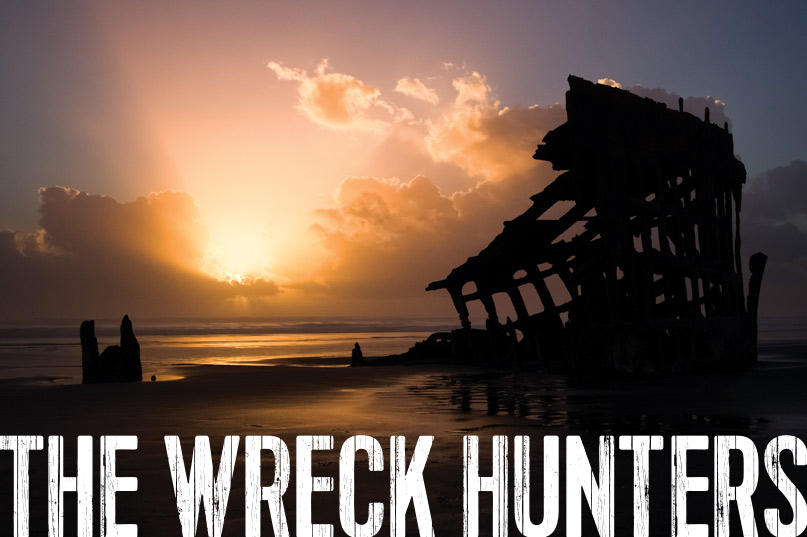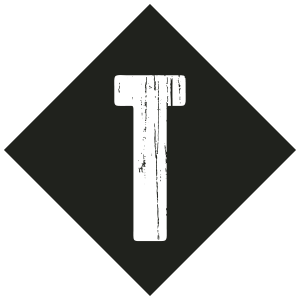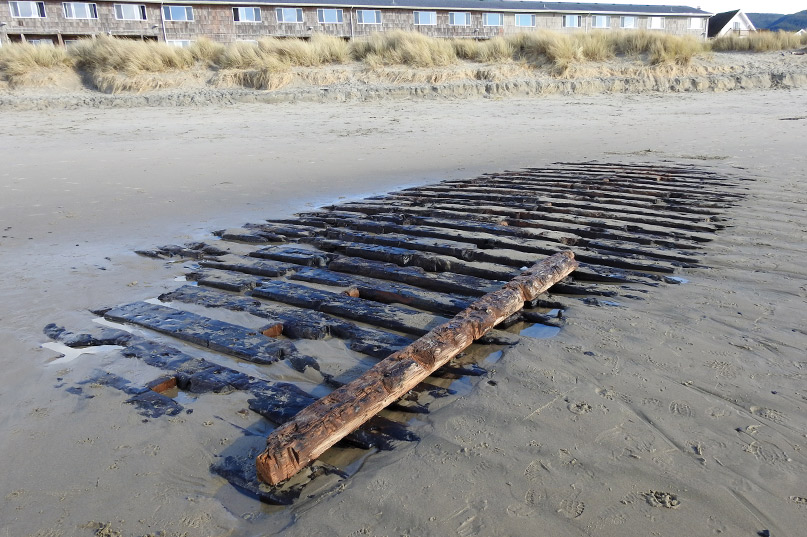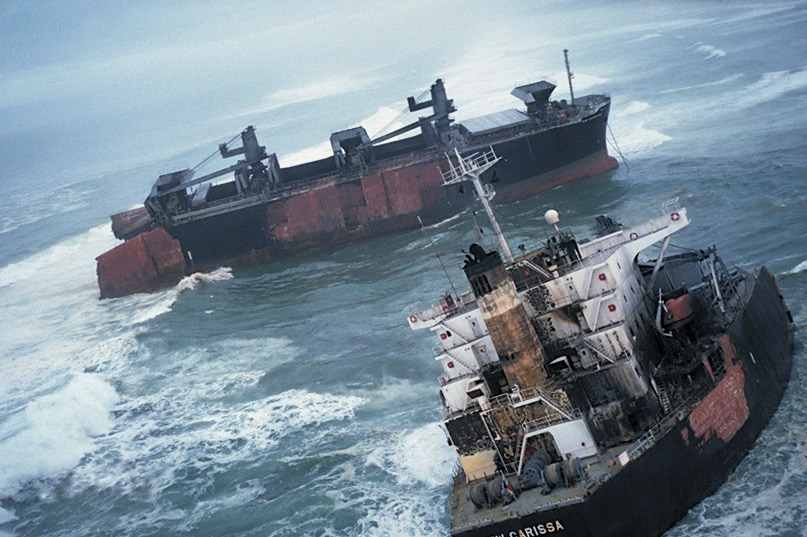
 This demands great patience, low tides, and a great deal of luck. Here are stories of wrecks I have seen and one that continues to evade me.
This demands great patience, low tides, and a great deal of luck. Here are stories of wrecks I have seen and one that continues to evade me.
Valentine’s Day 1908 was not a happy time for the men on the 215’ square rigger Emily G. Reed. Bound for Portland with a cargo of 2,100 tons of Australian coal, the ship spent 102 days at sea and Captain William Kessel was relying on Dead (deduced) Reckoning since his last sun shot days before. He thought he was on course for the lightship at the mouth of the Columbia. Unfortunately, he was about 50 miles south, preventing him from sighting the Tillamook Rock Lighthouse (built 1881) through the gloom.
The next landmark to the south is Neahkahnie Mountain (1680’ high) about a mile from the shore, but the sun had set long before and the officers were not aware how close they were to shore. It was after midnight when the lookout recognized there were breakers beneath the bow and ran aft to alert the captain. There was no way to stop the ship from disaster, and it slid silently onto the sandbar at the mouth of the Nehalem River, and ground to a halt.
This was not an isolated event; many hundreds of sailing ships approached the Columbia River every year and a handful of them would end their days on the beach. Seven or eight sailors died in this wreck and four of the crew recklessly launched a lifeboat from the stern and drifted north along the entire Washington Coast to Neah Bay, suffering terribly. But six people, including the captain and his wife, found what shelter they could in the foc’sle.
Morning found the ship firmly aground, with the tide low enough to enable them to wade ashore to the settlement of Nehalem, where they quickly found help. Like other shipwrecked crews, they were transported to Astoria by the U.S. Life Saving Service, where the official accident reports were filed. But the next tide re-floated the ship, and the Emily G. Reed began to drift down the coast. It soon came to its final resting at a place called Garibaldi Beach, where it broke in two pieces.
A pioneer named Elmer D. Allen recounts in the Jan. 18, 1954 edition of the Tillamook Headlight-Herald seeing the ship shortly after it foundered on the beach: “Among the last of the proud, old sailing ships, she lay fast in the sand, broken in two with a pile of coal two stories high; masts, spars and sails toppled and her cargo of coal dumped to the center holding firmly the fore and aft. The beach was strewn with wreckage and coal.”
The weight of the spars caused the ship to roll onto its side, and its valuable planking was soon stripped away. The hull slowly began to sink into the sand until it disappeared completely—only to re-appear every few years when storms washed the sand away. This continued until the late 1970s when it was submerged for so long that it was practically forgotten for good. Generations of children frolicked in the surf unaware of what lurked beneath their feet!

On December 1, 2007 the wind gods who had pounded so many ships to pieces brewed up a windstorm so powerful it was officially named the “Great Gale.” It blew for four days and devastated the region with 18 deaths and a gust measured at 147 mph. When it subsided, the beaches had been scoured for over 100 miles to a depth of several feet, exposing ghost forests, and other mysterious items. In Rockaway, the beachcombers found the side timbers of the Emily Reed had re-appeared.
She didn’t stay long, but came back again in the winter of 2010-2011, and soon became a minor celebrity thanks to the new world of smart phones and selfies. I drove down from Astoria to visit a friend who had bought a beach house there, but by the time I learned about the wreck, it was gone again. I wandered along the beach at low tide and stood where I thought the wreck laid. A few minutes later, I met Don Best, a longtime resident, historian, and photographer whose pioneer family has lived in a beach house near the wreck since the early 1900s.
He was born in 1943 and remembers playing in the wreckage as a young boy. He told me that his neighbors recalled filling buckets with coal that washed up on the sands. People were still finding chunks of wood from the wreck into the 1950s. His Father saved it to burn at Christmas; when the copper fasteners and sheathing gave off strange blue and green flames, so they called it “magic wood.” In the following years, I’ve spent several Christmases at my friend’s beach house, but never found any of the magic wood.

I forgot my dream of one day standing on the lonely wreck that lies far from its birthplace on the Medonak River in Waldoboro, Maine, (launched in 1880) and I completely missed the wreck’s appearance in February 2017. But a year later, I read about the ship’s latest sighting in the Daily Astorian, and excitedly checked the tide table to see if it would be uncovered in daylight. I called Don to check that it was still uncovered. Alas, he informed that it had already gone. Oh well, maybe next year?
I’ve never seen the 1846 wreck of the USS Shark on the Columbia Bar described as a “ghost ship,” but I’m adding it to my exclusive list. After all, what could be more ghostly than a disintegrating wooden warship finally releasing its grip on two of its cannons after 162 years? Well, how about one of them revealing that it was an 18-pounder cast by Wiggin & Graham of London in 1807 for the Royal Navy? I think even Captain Jack Sparrow would approve.
After a goodwill visit to the British staff at Fort Vancouver, the schooner-rigged Shark set off downriver and met its end on September 10, 1846, on the infamous Clatsop Spit where so many vessels have perished (including the Peter Iredale). But remarkably, all the crew of 70 survived, perhaps benefiting from naval discipline and waiting for the racing ebb tide to turn. They were all able to row ashore at low tide and hike back towards the small pioneer settlement of Astoria. The crew had lost everything, had to build shelters from driftwood, and rely on the local community for all their needs.

After three months, a British Hudson’s Bay Company ship was chartered to take them back to the East Coast. They safely rounded Cape Horn and never saw the Oregon Territory again. How could they have guessed that a part of their ship would survive to carry their history into the 21st century?
Back on the Columbia Bar, winter storms continued to pound the Shark’s hull until part of the deck was torn away. Like a raft, the bolted mass of timber drifted south until it washed ashore 30 miles south near Arch Cape. It was seen by a beachcomber in the breakers, with three cannons and a windlass still attached, before it disappeared beneath the sand for 50 years. In 1898, someone from the community of Elk Creek, Oregon, spotted one of the cannons. They managed to recover it at low tide using a horse team and put it on display in the village. In 1922, Elk Creek was becoming a popular resort distinguished by the 235’ Haystack Rock, and the town’s name was changed to the distinctive Cannon Beach.
Over a century passed before this zombie ship cast another relic to the surface. In February 2008, after the Great Gale eroded the Arch Cape beach, Miranda Petrone, a 12-year-old from Portland, was walking on the beach with her father Michael. The tide was out and they were exploring a “ghost forest”—the remains of ancient trees drowned by the encroaching sea centuries ago—exposed for the first time in 50 years.
Amongst the tangle of roots and stumps, she noticed a rocky mass with a patch of rust. Looking closer, they both realized this was something man-made, covered with a thick crust of hardened sand, pebbles, and shells. They walked back to their beach house and called the Nehalem Bay State Park campground to report the find. Within hours, state officials were on the scene and plans were made to excavate the object the next day before the shifting sand re-claimed it. Incredibly, as a crowd gathered to watch, a visitor named Sharisse Repp looked seaward and spotted something unusual—it proved to be the second cannon!
The local police made sure nothing was disturbed overnight and the next day, a backhoe arrived from the state park and made short work of clearing enough sand to pass a sling. Once both objects were hoisted up and safely on shore, everyone could see the outline of the cannons’ shape and the heavy wooden mounts they sat on.
The guns spent the next year in tanks of brine in the state park. In 2009, when an agreement was reached with Texas A&M University, the cannons were trucked to the Marine Archaeology and Conservation School still in their tanks and began a full conservation that lasted several years.

Once the hardened sand and rock concretion was carefully chipped away, the cannons were sent to an electronic reduction vat for nine months to pull out the chlorides that had leached into the metal from the salt. That was followed by more chemical baths to prevent any further corrosion.
Five years later in May 2014, they were returned to the Columbia River Maritime Museum in Astoria, where I met the father and daughter who found them. The half-ton guns were identified as carronades — close-range weapons about a quarter the size and weight of long-range cannons. They now sit on new wooden carriages in two climate-controlled cases in a redesigned gallery. The exhibit also features Shark Rock, a large boulder into which survivors of the shipwreck had carved their names.
In a complete contrast to historic wrecks making reappearances, the New Carissa was a modern ship that wrecked on February 4, 1999 and disappeared in the summer of 2008 in a thoroughly modern way. The mystery is how this 639’ Japanese wood chip carrier ran aground in the first place, and then the story turns to the poor decisions that caused its destruction. I remember watching in disbelief as one failure followed another.
The slow-motion disaster began on a typical “dark and stormy night” when the ship was refused entry to Coos Bay, Oregon, because breaking waves on the bar prevented the pilot boat from leaving. The captain took the fateful decision to anchor close to the beach overnight in 25-30 knot west winds and a heavy swell. The scope was too short, the anchor never dug in, and the ship was soon aground.

When the Fred Devine Diving and Salvage Company’s famous anchor tug Salvage Chief arrived from Astoria to re-float the ship on February 9, 1999 the crew were ready to set all three of the Chief’s massive 12,000-lb. anchors, knowing they had six powerful winches to pull the ship off an inch at a time, a system that had proved itself hundreds of times over 50 years. The hull was not leaking at this point, but Salvage Chief’s crew never got the chance because the official “Unified Command” managing the response—including the USCG and the insurers—refused to give permission.
They chose to wait for some big modern tugboats that were many days away, and according to crew I have interviewed, the failure to employ the Chief was a textbook example of “unintended consequences.” The stormy weather returned, the ship resumed pounding on the sand, and oil started to leak from the fuel tanks, threatening the bay and entire coastline. The goal now became the prevention of a disastrous oil spill, and the ship was written off.
That was just as well, because the methods that were employed completely destroyed it! On February 10, naval demolition teams were sent in by helicopter to ignite the 400,000 gallons of fuel with explosives. On February 11, the fire took hold and pictures of the ship ablaze on the beach were seen around the world. The fires burned for about 36 hours and the next day, weakened by the inferno, the New Carissa broke in two. There was still an estimated 135,000 gallons of oil in the tanks, so a new plan was hastily improvised. The two pieces of the ship would be towed out to sea and scuttled in deep water.
On March 2, the big Crowley tug Sea Victory towed the 440’ long forward half 40 miles out to sea in a rising storm until the towline snapped. The bow drifted north and ran aground near Waldport, Oregon. By now, the media had dubbed the New Carissa “the ship that refused to die.” On March 8, the tug again pulled the bow off the beach and towed it 300 miles offshore.
On March 11, a U.S. Navy destroyer, the USS David R. Ray, fired nearly a hundred rounds into the hulk but failed to scuttle it. Finally, a torpedo from the nuclear submarine USS Bremerton sunk the bow in over 10,000′ of water. The stern of the ship was still sitting on the beach and the bill had already reached $35 million. Now the lawyers took over. In April 2001, Oregon Governor John Kitzhaber declared he “didn’t want the ship owners leaving their trash in state waters,” and demanded the ship’s owner and insurers pay a $25 million bond to the state for removal, plus storage fees of $1,500 per day.
The ship’s owners filed a $96 million federal countersuit, blaming faulty National Oceanic and Atmospheric Administration (NOAA) charts that showed an inshore anchorage, lack of warning by a Coos Bay bar pilot, and large and unpredicted waves. Their case was dismissed. The state of Oregon filed suit in 2002 for the removal of the stern, the jury found the owners of the ship guilty of “negligent trespass,” and Oregon was awarded $25 million to pay for the removal of the ship.
Titan Salvage founder David Parrot testified that he could remove the stern using his two jack-up salvage barges based on the Gulf Coast. An expert witness for the owner disagreed, saying that severe injury or death was “virtually inevitable.” (I had my doubts, too.) The state felt Titan was the only salvage company that met its conditions and a price of $16.4 million was negotiated. In May 2008 the company’s two barges, the Karlissa A and B, arrived in Coos Bay.
I later learned from the salvage master Shelby Harris how the barges’ legs were driven into the sand, so that the deck could be jacked high above the wreck. This set-up required a reliable means of daily transportation out to the site for the crew of 20. The state would not allow a pier to be built, a helicopter would be too expensive, and the surf conditions made watercraft impractical. The chief engineer decided the only option was an aerial tramway—the first ever in a salvage operation. He inspected Portland’s system and local ski lifts, then designed and built their own rig to run across the 1,000′ of water and beach. How amazing is that?

I did a lot of negotiating to get on board and finally arrived early one morning in July 2008 to ride the tram out for my day on board, flying through the air, high above the waves. I met a team of highly-trained divers, proficient in underwater welding, demolition, and a host of related skills. This expert crew were already at work on the remaining 1,200 tons of ship using cutting torches. The work proceeded for 12-14 hours a day, seven days a week, with everyone wearing safety harnesses. By the time of my visit, much of the ship’s structure had been removed, exposing the engine room. Around noon, I watched as the entire machine shop was hoisted onto the small deck barge where it was cut into a pile of flat steel plate.
In the following weeks, the effort turned to attaching massive chains from the six hydraulic “pullers” on the barge. When the cylinders were pressurized, they exerted more than 2,000 tons of tension, but the wreck held fast. The next day, the crew rigged a 24″ pipe that blew compressed air under the wreck, blasting sand and mud out in a brown waterspout. More than a week passed before the hull finally broke free of the suction and the pullers lifted it about 14 feet.
Then cutting resumed, cautiously. By the end of August, the propeller was visible at low tide, and the final hurdle was cutting the keel and releasing the 250-ton diesel engine. When the last trace of the New Carissa was gone, the barges’ legs were jacked up and towed away, and this wild stretch of beach returned to its natural state.


